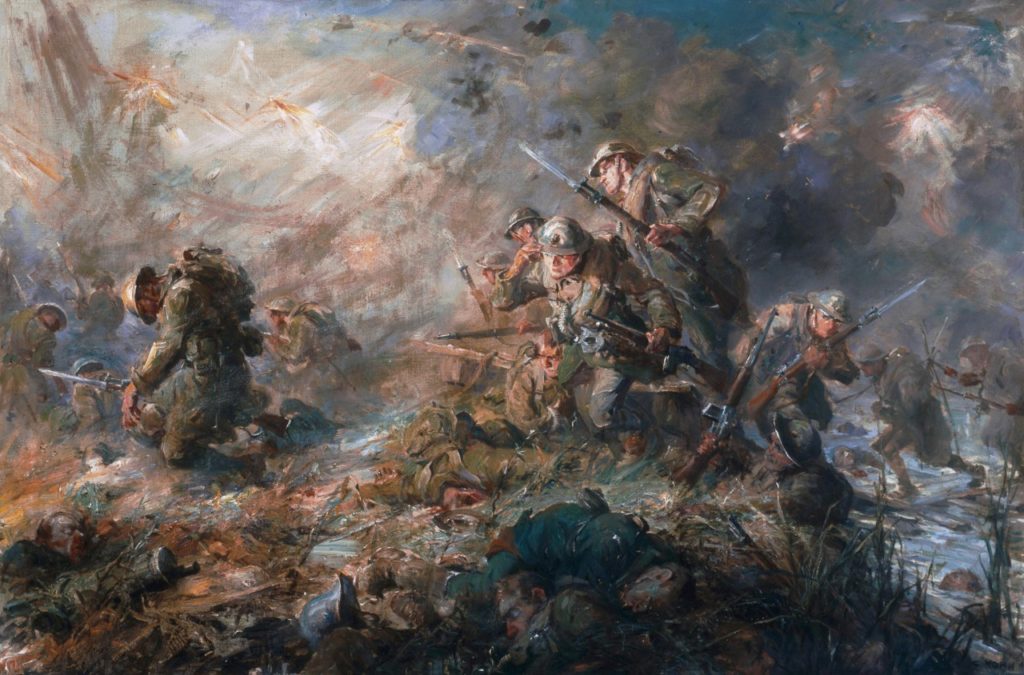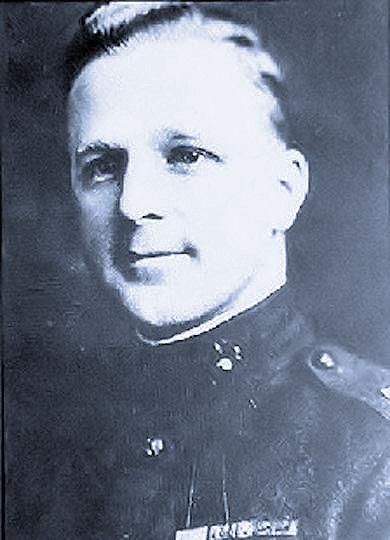Bullets were flying and men were falling on that deadly day at Belleau Wood in France. The counterattack by French, British and American forces on June 6, 1918, was designed to blunt the German Spring Offensive and protect Paris from capture.
At 3:50 a.m. that morning, Capt. George Hamilton of the U.S. Marine Corps led his company across an open farm field to secure the edge of the forested area — only to watch his troops be killed by lethal German machine gun fire moving like a scythe through the wheat that grew there.
With men hugging the ground and dying around him — Hamilton witnessed all five of his junior officers killed that morning — the captain recognized it was time for action. What he did next helped establish the legacy of the Corps as one of the toughest fighting units in the world and create his own legendary status as one of the bravest Marines in history.
Disregarding his own safety, Hamilton stood up in the withering fire and urged his men forward. He ran along the battleline, shouting orders and encouragement for them to leave the field and head into the trees of Belleau Wood.
With bayonets fixed, the Marines of 49th Company, 1st Battalion, 5th Regiment (1/5) rose en masse and charged the German positions. Hamilton led the attack into what became a bloody mele. He personally killed four Germans in fierce hand-to-hand combat.
More than a thousand Marines of the 4th Brigade would lose their lives that day in this first test of combat for the Corps in World War I. However, the individual acts of bravery by Hamilton and other Marines, including Sgt. Maj. Daniel “Dan” Daly, would lead the Corps to victory and a place in history.
Yet despite his heroics on that deadly day, Hamilton’s name rarely ranks when compared to names of Lt. Gen. Lewis B. “Chesty” Puller, Gunnery Sgt. John Basilone, and Maj. Gen. Smedley Butler.
In a 2003 article for Leatherneck Magazine, historian and retired Marine Lt. Col. Ronald J. Brown wrote, “George Wallis Hamilton may be the most overlooked Marine hero of all time. When the First World War ended in 1918, Hamilton was hailed by his peers as ‘the bravest of the brave’ and by his senior officers as ‘the finest officer in the entire American Expeditionary Forces.’ His feats on the battlefield could have earned him a Medal of Honor on no less than three different occasions, but none came his way.”
A Hero Denied?
Hamilton’s heroics were not over, however. The captain and his men had to cross another clearing in a running charge to take Hill 142, their main objective that day. Company 49 captured several machine gun positions and scores of enemy prisoners.
So stunned were the Germans — used to a certain French lethargy by this time in — by the American attack that they started referring to the Marines as “Teufel Hunden”: Devil Dogs.
While his company suffered more than 50 percent casualties at Belleau Wood, Hamilton himself miraculously walked away unscathed. In fact, the captain would suffer no wounds in World War I despite exposing himself to deadly enemy fire several times.
“What saved me from getting hit I don’t know,” Hamilton later wrote about his experience. “Although I lost heavily here, I came out unscratched.”
Col. Wendell Neville, commander of the 5th Marine Regiment and Medal of Honor recipient himself, cited Hamilton’s “extraordinary heroism… at great personal exposure” on that day in recommending the captain for the Medal of Honor.
His “rare quality of leadership is apparent… [A]fter men had lost their leaders, he ran up and down the line under severe fire, leading his men forward and urging them on…,” wrote Neville.
GET HISTORY’S GREATEST TALES—RIGHT IN YOUR INBOX
Subscribe to our HistoryNet Now! newsletter for the best of the past, delivered every Monday and Thursday.
However, instead of the nation’s highest award for bravery, Hamilton received the Navy Cross and Distinguished Service Cross, as well as two Croix de Guerre from the French government. Despite recommendations that he went “above and beyond the call of duty,” the Marine was denied the Medal of Honor — with some saying that U.S. Army Gen. John J. Pershing, commander of the American Expeditionary Force in World War I, personally denied Hamilton the award.
It is possible that longstanding prejudice between the Army and the Marines was responsible for the rejection.
Mark Mortensen, author of “George W. Hamilton, USMC: America’s Greatest World War I Hero” in 2011, posits that Pershing’s prejudice against the Corps played a factor.
At the time, the general did not want the Marines to fight in France during the Great War, but Pershing was eventually overruled by the secretary of war, Newton Baker. It was the only time the Corps was released by the Navy and put under Army command.
“One brigade, the Marine 4th, was allowed to fight — but had to wear Army uniforms. Some Marines would add the Marine Corps symbol of the globe and eagle to their helmets so they would stand out,” wrote Mortensen.
Over the course of the war, no commissioned Marine Corps officers in the 4th Brigade were bestowed with the Medal of Honor.
The War Goes On
Despite the infighting within command, Hamilton again distinguished himself at Blanc Mont on Oct. 4, 1918. Now a major commanding the 1/5, he famously led the attack that captured the summit, then held on against vicious counterattacks that included gas, artillery and hand-to-hand combat.
At one point while they wore gas masks, Hamilton stood shoulder to shoulder with his men, firing pistols at the enemy as they tried to retake the ridge.
Once again Hamilton was recommended for the Medal of Honor for actions at Blanc Mont — and again he was denied.
Despite rumors circulating about the possible end of the war the next day, Hamilton was unceasing in his attacks, leading elements of the 1/5 and 2/5 across the Meuse River to capture enemy positions on the evening of Nov. 10, 1918.
Under heavy German shelling, the Marine officer led yet another charge across a pontoon bridge — which was later famously depicted in Frederick C. Yohn’s 1920 painting, “The Last Night of the War.”

One of his men later wrote, “The major blew a single shortened blast (of his whistle) and stepped forward … He never sent a fellow where he wouldn’t go himself.”
The attack was successful with the Marines capturing three elevated ridges and held them against enemy resistance. As dawn broke on Nov. 11, Hamilton received word that the armistice was to go into effect at 11 a.m. He was the last field officer notified of the pending truce.
Postscript of a Marine
With the war over, Hamilton left the Corps briefly, only to return so he could pursue his dream of becoming a pilot. In 1921, as a captain in the peacetime Marines, he entered the student naval aviator program at Pensacola, Fla. He completed his training later that year and earned his wings.
On June 25, 1922, the 5,000-man Marine Expeditionary Force hiked to Gettysburg in preparation for maneuvers at the national battlefield site. Its mission was to recreate Pickett’s Charge using modern military equipment for President Warren G. Harding on July 1. Hamilton was assigned to provide air support for the ground troops.
The next day, the Marine Corps pilot, commanding the Second Squadron in a De Havilland DH-4B two-seat biplane, led a formation of five aircraft over Gettysburg. At about 1 p.m., Hamilton signaled he was going to land and then began his descent. His plane went into an uncontrollable tailspin and crashed, killing him instantly. The second person in the aircraft, Sgt. George R. Martin, died at a hospital.
An investigation of the incident provided inconclusive results. Speculation centered on turbulent winds as the cause of the crash, though mechanical failure and pilot error could not be ruled out. The man who fearlessly escaped death from bullets, artillery and gas in World War I was now dead.
Three days after his death, Hamilton was buried with full honors at Arlington National Cemetery. His funeral was attended by top military brass and various dignitaries, including Assistant Secretary of the Navy Franklin Delano Roosevelt.
Following his interment, one newspaper wrote of Hamilton: “His record is one of the greatest and noblest in the World War. General Pershing said of him, in official citations… [that he] ‘displayed the highest type of courage and leadership when his command was under decimating fire from the front and both flanks.’”
The article added, “the history of the World War would be incomplete without the name of George Wallis Hamilton.”
historynet magazines
Our 9 best-selling history titles feature in-depth storytelling and iconic imagery to engage and inform on the people, the wars, and the events that shaped America and the world.






